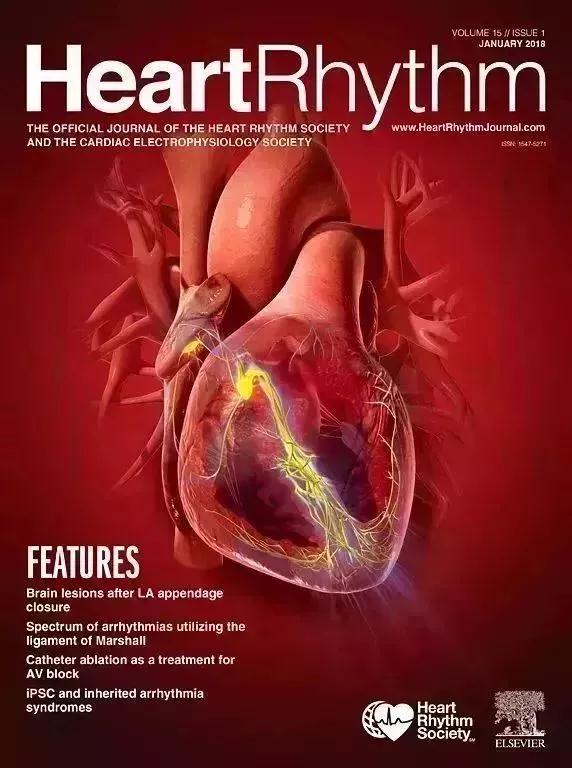<< First issue in October 2020 >>
Come and listen to the editor in chief to introduce the most authoritative international heart rhythm research results

The October issue is a focus issue on sudden cardiac death. The first original article is titled “Left cardiac sympathetic denervation reduces skin sympathetic nerve activity in patients with long QT syndrome”. The authors recorded skin sympathetic nerve activity before and after left cardiac sympathetic denervation. They found that left cardiac sympathetic denervation provides an inhibitory effect on cardiac sympathetic activity by suppressing burst discharges of the sympathetic nerves.
Next up is “Comparison of Cardiovascular Screening in College Athletes by History and Physical Examination with and without an Electrocardiogram”. The authors extracted data from over 8000 records and found 11 conditions associated with sudden cardiac death. They found that history and physical examination with the addition of ECG is 6 times more likely to detect a cardiovascular condition associated with sudden cardiac death than without ECG. The addition of ECG improves the cost efficiency per diagnosis by 5-fold and should be considered at college institutions with appropriate resources.
The following article is titled “Improvement in sudden cardiac death risk prediction by the enhanced American College of Cardiology/American Heart Association strategy in Chinese patients with hypertrophic cardiomyopathy”. The present study consisted of 1369 consecutive adult patients with HCM without a history of sudden cardiac death events. During an average of 3.2 years of follow up, 39 patients reached sudden cardiac death end points of whom 26 (66.7%) were correctly predicted as those at a high risk of sudden cardiac death by using methods recommended by the 2019 enhanced ACC/AHA strategy. The authors conclude that the 2019 enhanced ACC/AHA strategy showed better predictive performance for sudden cardiac death risk stratification in Chinese patients with HCM, with a notably high sensitivity.
Coming up is paper titled “Automated electrocardiographic quantification of myocardial scar in patients undergoing primary prevention implantable cardioverter-defibrillator implantation”. The authors aimed to assess the value of an automated version of the Selvester QRS score for the prediction of ICD therapy and death in patients undergoing primary prevention ICD implantation. The study included over 1000 patients with both ischemic and nonischemic cardiomyopathy. They found that the automatically calculated Selvester QRS score, an indicator of myocardial scar burden, predicts mortality and appropriate and inappropriate shocks in patients undergoing primary prevention ICD implantation with a prolonged QRS duration.
The next article is “Sudden cardiac arrest with shockable rhythm in patients with heart failure.” The authors studied 648 subjects with heart failure and sudden cardiac arrest to determine which patients had shockable rhythm such as ventricular fibrillation and tachycardia. They found that the rates of shockable rhythm during sudden cardiac arrest depend on the heart failure clinical subtype. Patients with heart failure and left ventricular ejection fraction between 40% and 50% had the highest likelihood of shockable rhythm, correlating with the highest rates of survival.
Coming up next is “Diagnostic yield and long-term outcome of non-ischemic sudden cardiac arrest survivors and their relatives - results from a tertiary referral center”. The authors studied 155 probands with sudden cardiac death and 282 relatives. They identified an inherited cardiac disease in 76 (49%) probands and 42 (15%) relatives. The authors conclude that systematic workup of nonischemic sudden cardiac arrest survivors and their relatives identified an inherited cardiac disease in 49% of referred probands and 15% of their relatives. The favorable long-term prognosis of diagnosed relatives probably not only reflects lower age but also the effects of early diagnosis, treatment, and follow-up. These findings support systematic workup of sudden cardiac arrest survivors and their relatives.
The next paper is “Higher Baseline Cardiorespiratory Fitness is Associated with Lower Arrhythmia Recurrence and Death Following Atrial Fibrillation Ablation”. The authors studied 591 patients who underwent exercise stress testing within 12 months before AF ablation. During mean follow-up of 32 months after ablation, the authors found that higher cardiorespiratory fitness is associated with reduced arrhythmia recurrence rates and death among patients undergoing AF ablation. These findings suggest that enhance cardiorespiratory fitness before AF ablation may improve outcome of ablation. A prospective clinical trial will be needed to test that hypothesis.
Coming up is a paper titled “Long-term Outcomes of Ventricular Tachycardia Substrate Ablation Incorporating Hidden Slow Conduction Analysis”. 70 consecutive patients undergoing VT substrate ablation were prospectively included. Bipolar electrograms with >3 deflections and duration<133 ms were considered as potential hidden slow conduction electrograms. The authors found that VT substrate ablation incorporating hidden slow conduction analysis allowed further arrhythmic substrate identification (especially in the border zone and normal voltage areas) and was associated with increased ablation efficiency and better short- and long-term outcomes.
The next paper is titled “Ventricular Tachycardia in cardiolaminopathy: characteristics and considerations for device programming.” The natural history of VT amongst patients with cardiolaminopathy is incompletely understood. The authors enrolled cardiolaminopathy patients with primary or secondary prevention ICDs and followed them for 2 years. They found that VT is recurrent and highly responsive to antitachycardia pacing, which supports the use of transvenous ICDs iteratively programmed to manage VT of various tachycardia cycle lengths. The onset of high-burden VT indicates poor prognosis and should warrant referral to a heart failure specialist.
Next article is “QRS morphology in lead V 1 for the rapid localization of idiopathic ventricular arrhythmias originating from the left ventricular papillary muscles: A novel electrocardiographic criterion”. The authors studied 170 patients with LV papillary muscle ventricular arrhythmias, including 64 (55%) from the posteromedial papillary muscle and 47 (42%) from the anterolateral papillary muscle. Papillary muscle ventricular arrhythmias showed 3 distinct QRS morphologies in lead V1 93% of the time: Rr (53%), R with a slurred downslope (29%), and RR (11%). The intrinsicoid deflection of papillary muscle ventricular arrhythmias in lead V1 was shorter than that of the reference group. The authors conclude that ventricular arrhythmias originating from the LV papillary muscles manifest unique QRS morphologies in lead V1, which can aid in rapid and accurate localization.
Coming up next is an article titled “Outer loop and isthmus in ventricular tachycardia circuits: Characteristics and implications.” The authors performed complete substrate activation mapping during sinus rhythm and full activation mapping of the VT circuit in 6 postmyocardial infarction patients. The VT circuit was a figure-of-eight reentrant circuit in 4 patients and a single-loop circuit in 2 patients. The authors found that in ischemic reentrant VT circuits, the outerloop contributes significantly to reentry with multiple corridors of slow conduction. These corridors can result from structural or functional phenomena. Isthmus boundaries may correspond to functional or fixed lines of block.
The next paper is “Loss of Ventricular Pre-excitation During Non-invasive Testing Does Not Exclude High-Risk Accessory Pathways.” The authors studied 1589 patients. Among them, 244 (15%) had nonpersistent preexcitation and 1345 (85%) had persistent preexcitation. There was no difference in shortest preexcited R-R interval at EP study. Of 61 patients with sudden cardiac arrest or rapidly conducted preexcited AF, 6 (10%) had nonpersistent preexcitation, including 3 sudden cardiac arrest. The authors conclude that nonpersistent preexcitation was associated with fewer high-risk accessory pathways, though it did not exclude the risk of sudden cardiac arrest or rapidly conducted preexcited AF in children with WPW.
In addition to the above sudden death focused articles, the October issue also includes regular articles.
The first one is titled “Durability of posterior wall isolation after catheter ablation among patients with recurrent atrial fibrillation.” The authors studied 50 patients undergoing repeat AF ablation after previous posterior wall isolation. Of them, 30 had durable posterior wall isolation at repeat ablation. Patients with posterior wall reconnection required repeat ablation earlier and were more likely to have atypical atrial flutter. Among patients with posterior wall reconnection, the roof was the most common site of reconnection.
Coming up next is “Risks and outcomes of gastrointestinal malignancies in anticoagulated atrial fibrillation patients experiencing gastrointestinal bleeding”. Over 10,000 anticoagulated AF patients hospitalized due to GI bleeding without a previous history of GI cancer were identified from the Taiwan National Health Insurance Research Database. Patients were followed-up for incident GI cancers for up to 1 year. Incident GI cancers were diagnosed in 1 of 37 AF patients at 1 year after oral anticoagulation-related GI bleeding. Detailed examinations for occult GI cancers are necessary, especially among elderly males.
The next article is “Ten-year Outcomes of Transcaval Cardiac Puncture for Catheter Ablation after Extracardiac Fontan Surgery”. The authors performed 23 EP procedures requiring pulmonary venous antrum access in 17 extracardiac conduit Fontan patients. Cavoatrial overlap was identified in 14 patients by preprocedural imaging. Pulmonary venous access was obtained via Transcaval Cardiac Puncture in 11, direct conduit puncture in 6, pre-existing fenestration in 5, and pulmonary artery puncture in 1. No procedural complications occurred. No change in oxygen saturation was noted, and no evidence of residual shunting was detected by follow-up echocardiography. These findings show that Transcaval Cardiac Puncture is feasible in most patients after extracardiac conduit Fontan surgery and can be predicted by preprocedural advanced imaging.
Coming up next is an article titled “A novel nine-partition method using fluoroscopic images for guiding left bundle branch pacing.” The authors enrolled 70 patients who underwent His bundle or LBB pacing. The region between the apex and the ventricular contraction ring was divided into 9 partitions using fluoroscopic image. All His bundle pacing leads were distributed in the second partition, and 94% of LBB pacing leads were in the junctional area of second and fifth partitions. Under the guidance of the 9-partition method, the success rate of LBB pacing in 30 prospective patients increased from 58% to 83%. This new 9-partition method is useful to guide successful LBB pacing.
The following article is “Purkinje System Hyperexcitability and Ventricular Arrhythmia Risk in Type 3 Long QT Syndrome.” Frequent fascicular/Purkinje-related premature ventricular contractions and short-coupled ventricular arrhythmias are suggestive of Purkinje system hyperexcitability. Overall, 30 of 91 patients with LQT3 (33%) exhibited evidence of presumed Purkinje system hyperexcitability. There was an increased risk of ventricular fibrillation events in individuals with LQT3 and Purkinje system hyperexcitability. Interestingly, variants in the voltage-sensing domain regions of Nav1.5 were more frequently observed in patients with LQT3 and Purkinje system hyperexcitability than those without. Further study is needed to determine whether a distinct cellular electrophysiology phenotype underlies this phenomenon.
The next paper is “Use of Virtual Visits for the Care of the Arrhythmia Patient”. The authors studied 100 consecutive virtual visits. Patients rated their experience as either excellent/very good, with high overall level of satisfaction. 60% preferred a virtual visit for their next visit and 19% preferred an in-office visit. These findings suggest that most patients and physicians prefer virtual visits. Convenience, cost, and reason for follow-up were important determinants that affected both patient and physician preference.
In addition to the above original article, there is a contemporary review titled “The electrocardiographic interpretation of pacemaker algorithms enabling minimal ventricular pacing”. This review highlights and illustrates the features of different pacing algorithms as they appear on ECG, and discusses other situations that result in unintended ventricular pacing. That paper is followed by a “HRS white paper on atrial fibrillation centers of excellence: Rationale, considerations, and goals.” We mourn the loss of Dr Hein Wellens, a pioneer in EP and a mentor to many. Drs Mel Scheinman and Andrew Wit each provided an article in memory of Dr Wellens. We also remember the passing of Dr Jimmy JianMing Li.
I hope you enjoyed this podcast. For Heart Rhythm, I’m Editor-in-Chief, Dr. Peng-Sheng Chen.

